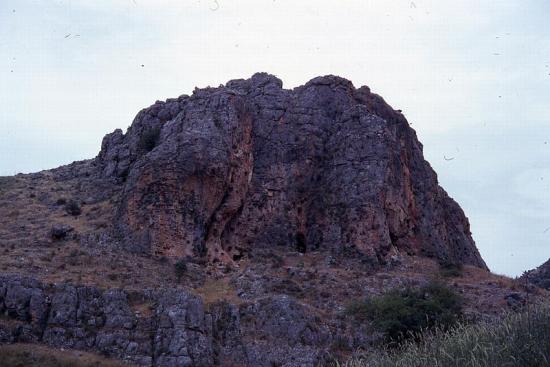Source - http://popular-archaeology.com/issue/june-2013/article/neanderthals-changed-hunting-strategy-with-climate-change

A view of Amud Cave from below. Wikimedia Commons
Neanderthals occupying the Amud Cave in what is today northern Israel showed exploitation of different hunting territories depending upon the climate in which they lived, suggests researchers in a recent study.
Gideon Hartman of the University of Connecticut and colleagues from an international group of universities and research institutions came to this conclusion by reconstructing the hunting ranges of Neanderthals who occupied the cave at two distinct Ice Age occupational phases separated by about 10,000 years. The first phase occurred during Marine Isotope Stage (MIS) 4 (71,000 – 129,000 years ago), and the second occurred during Marine Isotope Stage 3 (57,000 – 70,000 years ago). They analyzed the comparison of oxygen, carbon, and strontium isotope samples from the tooth enamel of excavated gazelle remains with modern isotope data from the Amud Cave region.
What they found was that the Neanderthals had restricted their gazelle hunting to the higher elevations west of the cave during the earlier occupation phase, but became more diverse in their hunting ranges during the later occupation phase, with an emphasis on the lower elevations closer to the cave site. The researchers suggest the possibility that drier conditions during the earlier phase (MIS 4) may have forced the gazelle populations to forage in the higher elevations where food sources were more plentiful.
“This study showed that Neanderthals adjusted their hunting territories considerably in relation to varying environmental conditions over the course of occupation in Amud Cave,” stated Hartman, et al., in the study abstract.*
Amud Cave overlooks the Wadi el ‘Amud (a dry river gorge) northwest of the Sea of Galilee in present-day Israel. It is best known for its Neanderthal remains, including the ‘Amud 1’ adult male skeleton, which features a large cranial capacity and other characteristics similar to that of the famous Neanderthal remains discovered in Shanidar Cave in Iraqi Kurdistan. Also found within the cave was the partial skeleton of an 8-to-10-month-old Neanderthal baby with a maxilla bone of a red deer situated above the baby’s pelvis. Archaeologists suggest the possibility that the maxilla had been purposely placed over the baby’s remains as a burial rite.
Gideon Hartman, et al., Isotopic evidence for Last Glacial climatic impacts on Neanderthal gazelle hunting territories at Amud Cave, Israel, Journal of Human Evolution, 7 May 2015 doi:10.1016/j.jhevol.2015.03.008